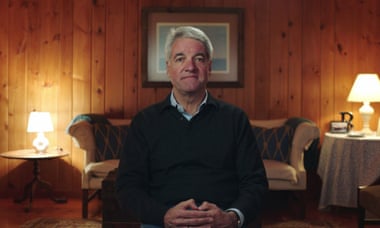Currently on an extended release in theatres and already earning itself awards buzz, Fire of Love, Sara Dosa’s breathtaking documentary about the relationship and career shared by French volcanologists Katia and Maurice Krafft, is the surprise independent hit of the summer. But Dosa is not the only director to be inspired by the extraordinary daring of the Kraffts.
In 2016 Werner Herzog released his documentary Into the Inferno, which sparingly included clips from preserved reels out of the couple’s extensive collection. The meat of that film followed present-day volcano expert Clive Oppenheimer, now tapped for a scientific adviser role on Fire of Love, which draws more heavily on the Krafft archive in its all-vintage-filmstrip format of storytelling. In Dosa’s film, the most intrepid home movies ever made gain fresh vitality in their combination with Miranda July’s narration. Indeed the inclusion of July is the main factor setting Dosa’s feature apart from a second Herzog volcano documentary, The Fire Within, which also focuses solely on the Kraffts and uses much of the same footage. Without Oppenheimer’s guidance or a US distribution deal in place, Herzog’s doppelganger film, debuting months after Fire of Love, has been all but relegated to obscurity.
Film geeks will sometimes amuse themselves and each other by rattling off instances of competing films, coincidences (or quirks of industry trend-chasing) that result in two films with approximately similar plots rolling out around the same time: A Bug’s Life and Antz, Armageddon and Deep Impact, Portrait of a Lady on Fire and Ammonite. Though as of late, far more redundancies along these lines concern the non-fiction side of the film world, and they seldom have that whimsical sense of happenstance in their overlap.
Over the past couple of years, there’s been a preponderance of twinned documentaries offering alternate angles on the same subject, an odd spike motivated by the tricky logistics of archival film-making. As the range of the past documented in moving pictures continues to expand, documentaries hinging on exhumed private footage and reels found somewhere in a vault have multiplied, in some cases leading to crowding. And though the offscreen rationales for doubled projects often pertain to matters of licensing and legality, the questions they raise about artistic perspective and blinkered vantage points can be illuminating all on their own.
Rather than shared fascination with a pet topic, most of these head-to-head releases derive instead from a race to relevance between those wrestling to get their finger on the pulse first. The culture commentary site The Ringer produced a well-liked podcast about the debacle of the Woodstock music festival of 1999 through summer 2019, which they then adapted into the even-more-popular HBO miniseries Woodstock 99: Peace, Love, and Rage for the summer of 2021. Netflix resolved to get a piece of the action and rush-ordered its own version, Trainwreck: Woodstock ’99, for a debut this summer. Because the HBO doc pretty thoroughly covered the sociological significance of an event that spiraled into violent chaos due to an undercurrent of chauvinism in the nu-metal zeitgeist, the Netflix equivalent forgoes bird’s-eye analysis for boots-on-the-ground detail, offering little except the opportunity to spend more time immersed in a queasy footnote of music history.
An even starker contrast emerged from the dueling Fyre festival docs, concurrently pieced together by Hulu (Fyre Fraud) and Netflix (Fyre: The Greatest Party That Never Happened), then released in the same week. Each one got its own “in” to access, the former interviewing con artist head honcho Billy McFarland for a substantial cash payment while the latter partnered with the fest’s digital marketing firm FuckJerry to get into their treasure trove of footage. On both sides, this choice implies an ethical compromise then borne out by the framing of the finished work: the FuckJerry-approved version largely elides the company’s role in the quagmire and its cover-up, whereas the McFarland-involved production offers him a platform (and a payout) along with the rope to hang himself.
By its nature, non-fiction cinema entails a subtle negotiation over who gets to tell a story, and the most minute differences in head-to-head documentaries lay bare the concessions and limitations inherent in that process.
No documentary occupies a vantage of absolute objectivity, and difficult decisions about acceptable imperfections must be made, one hopes with transparency and good intentions. Ben Berman tries to get out in front of the issue with The Amazing Jonathan Documentary, incorporating the appearance of a rival camera crew also seeking to shoot a portrait of an ailing comedian-magician as a plot twist. In working on his Anthony Bourdain film Roadrunner, director Morgan Neville declined to interview Bourdain’s longtime girlfriend Asia Argento in the understanding that her attachment to the film could alienate a larger number of other participants.
Doubled documentaries allow viewers to explore the road not traveled, and to see how behind-the-scenes methodology can have a tangible effect on content by placing their comparison points side by side – although sometimes the sheer volume of releases can itself be morally questionable: the endless documentaries about the invasive treatment of Britney Spears by the media have raised questions about whether the documentaries themselves are doing the same.
If the assembly line churning out documentaries on the day’s hot topic keeps on growing – this year, it’s the GameStop stock short about which at least two documentaries have been made, and next year, it’ll be something else – then non-fiction cinema may soon come to resemble news media, putting forth varying takes and leaving the public to sort through the disparities. In this saturation of viewpoints, all we can do is weigh the points of view, and try to triangulate the point in the middle where the truth tends to hide.

